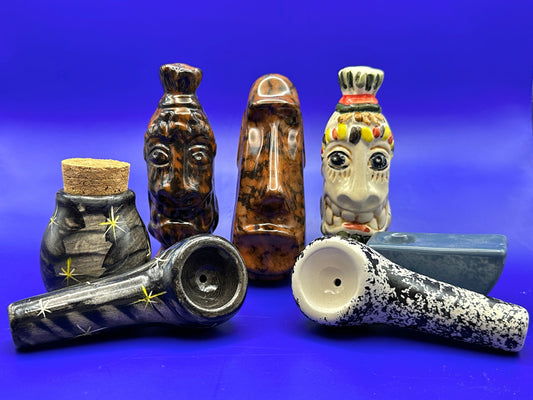I. The Anatomy of a Weed Pipe:
To comprehend how a weed pipe functions, it is essential to first explore its fundamental components. A typical ceramic pipe consists of four main parts: the bowl, the chamber, the mouthpiece, and the carb hole. Each element plays a crucial role in delivering a satisfying smoking experience.
A. The Bowl:
The bowl, usually situated at one end of the pipe, serves as the receptacle for the smoking material, such as dried herbs or cannabis flower. The bowl's design allows for easy packing and ignition of the substance.
B. The Chamber:
The chamber, located adjacent to the bowl, acts as a reservoir to hold the smoke produced during the smoking process. Its size directly affects the amount of smoke that can be accumulated before inhalation.
C. The Mouthpiece:
The mouthpiece is the section of the pipe where the user places their lips to inhale the smoke. It is crucial for the mouthpiece to be comfortable and easy to use, as it directly influences the overall smoking experience.
D. The Carb Hole:
The carb hole, a small opening usually found on the side of the pipe, serves as a control valve. By covering and releasing the carb hole while inhaling, the user can regulate the airflow, resulting in more efficient and enjoyable hits.
II. The Science of Smoke Formation:
Now that we have examined the components of a ceramic pipe, let's explore the scientific process behind smoke formation. When the user ignites the smoking material in the bowl, several chemical reactions occur.
1. Combustion:
As the material heats up, combustion takes place, leading to the breakdown of complex organic compounds. This process releases smoke, which contains various substances, including cannabinoids, terpenes, and other volatile compounds found in the plant matter.
2. Vaporization:
Simultaneously, vaporization occurs, wherein the heat applied to the material converts cannabinoids, such as THC, into a gaseous state. This conversion allows for the psychoactive compounds to be inhaled and absorbed by the user's respiratory system.
III. Airflow and the Carb Hole:
Effective airflow is essential for a satisfying smoking experience. The carb hole plays a crucial role in controlling this airflow. By covering the carb hole during ignition and releasing it while inhaling, the user can regulate the entry of air into the chamber.
1. Ignition:
When the user ignites the smoking material in the bowl, they cover the carb hole to restrict airflow. This action creates a vacuum-like effect, pulling the smoke into the chamber and preventing it from escaping through the mouthpiece.
2. Inhalation:
To inhale the accumulated smoke, the user releases the carb hole, allowing fresh air to enter the chamber. This influx of air displaces the smoke, causing it to move towards the mouthpiece. By inhaling through the mouthpiece, the user draws the smoke into their lungs, experiencing the desired effects.
IV. Cleaning and Maintenance:
To ensure optimal performance and longevity, proper cleaning and maintenance of a ceramic pipe are vital. Residue from previous smoking sessions can accumulate over time, affecting both the taste and functionality of the pipe. Regular cleaning pipe with appropriate cleaning solutions helps maintain the pipe's efficiency and extends its lifespan.
The science behind a weed pipe, particularly a ceramic pipe, is a fascinating realm that sheds light on the intricate processes involved in smoking. Understanding the anatomy, smoke formation, and airflow dynamics allows users to appreciate the design and functionality of this popular tool. By acknowledging the science behind smoking, individuals can enhance their experience and make informed choices when indulging in this age-old tradition.








